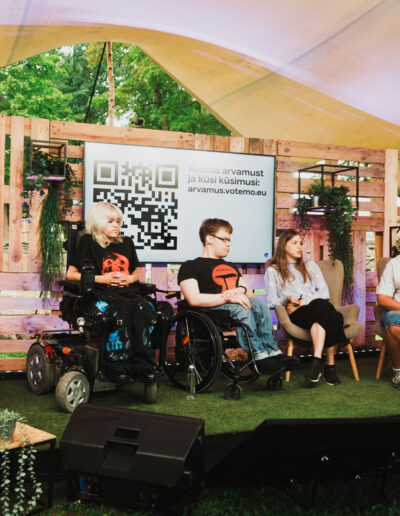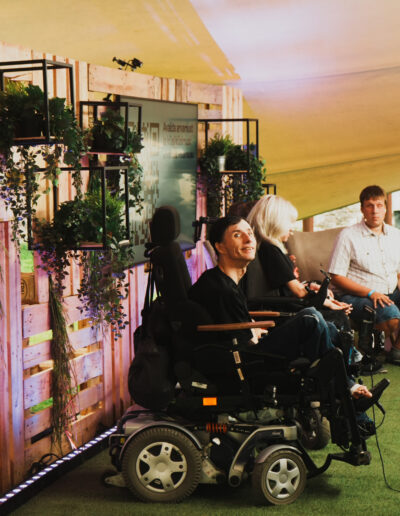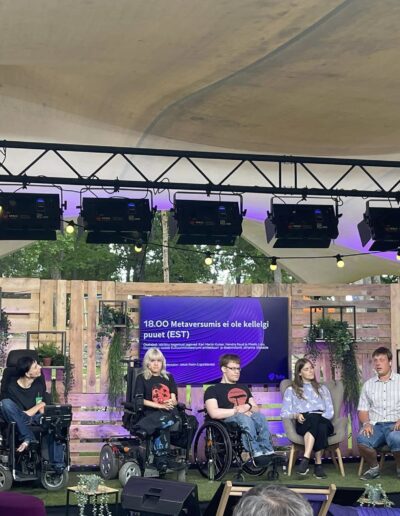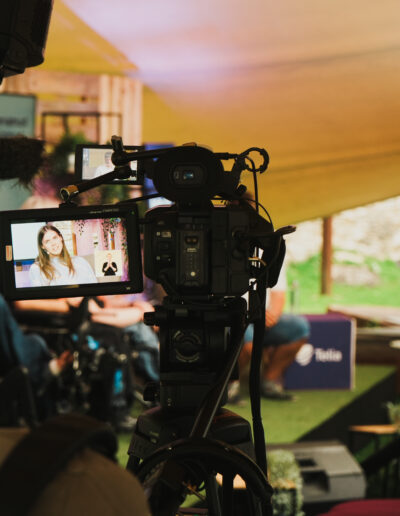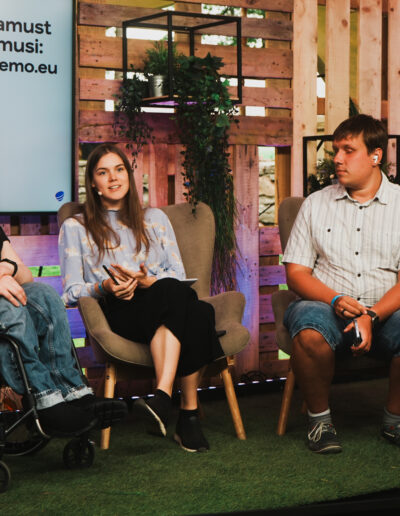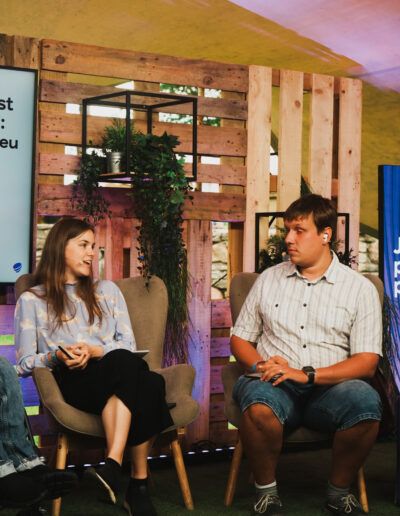Opinion Festival 2023
11th August 2023 was a day of great honor for me as I participated in the Opinion Festival in Paide alongside Jakob Rosin, Johanna Jõekalda, Hendra Raud, and Karl Martin Kutser. The topic of the discussion was ‘No Disabilities in the Metaverse’
Below you can read the translation of my prepared text into English. Watch the conversation on Telia’s Facebook page [LINK].
* * *
My name is Meelis Luks, and I come from the capital city of Estonia. Although I’m widely known as Mella, which is my artist’s name. I’ve found my way in the world of art by painting on canvas with a brush between my toes. I work as a specialist at Swedbank. But unbelievably, my nickname “Mella” comes from the world of computers!
Speaking of computers, I got a glimpse of their wonders many years ago when my sister brought home a printed Mona Lisa. But let’s not be mistaken – it wasn’t an ordinary photo or drawing. Oh no! It was a creation of an old-style mainframe computer. An image composed of letters and characters, presenting a black and white version of the world-famous masterpiece by Leonardo da Vinci. Even back then, I was fascinated by how a machine could generate such an image from a painting.
During that period, I pursued a hobby involving crafting typewriter art using a mechanical typewriter, similar to the process employed in creating the Mona Lisa. The distinction, however, lay in the fact that my own imagination was the driving force behind my creations.
But let’s fast forward a bit. My first computer-like device was at home in the early ’90s – a school computer named Juku. Unfortunately, Juku had its glitches and tended to crash often. Since then, my life has been intertwined with various smart machines. In 1995, when I already had a PC and first got online, a new and exciting world opened before me. A world that helped shape me into who I am today.
It’s true that I’ve mostly acquired my IT knowledge on my own, so you could say I’m my own teacher! I’ve always been drawn to learning new things and exploring their possibilities.
But when did I discover the enchanting virtual world? I believe many of you haven’t even heard of things like telnet-based chat rooms. But be aware that I’ve had the privilege to be a developer and administrator of such a chat room! My grand title in this telnet-based chat room was “God”.
But what exactly was this telnet-based chat room like? Did it involve the magic of pictures and sounds? Could you hear the conversations of others in the chat room? Did users have cool avatars by which they were known? Oh no, none of that! Everything happened purely in text. Yes, so simple, and yet so cool!
This chat room was filled with various commands that allowed us to communicate, move through virtual streets and rooms, express our feelings, look around, and so on. For example, movement was done with the command “go,” followed by the name of the place linked to the room you were in. It was a true virtual adventure, a precursor to today’s similar virtual environments.
But what made this chat room special? In that virtual world, there were no obstacles for me! I was on an equal footing with others, without any disabilities or special needs. It was easy to express myself, whether by virtually walking or speaking aloud. Although, to be honest, I’ve never actually walked or spoken independently, but in that chat room, I could do it all!
That virtual world gave me the opportunity to truly be free and communicate with people where it didn’t matter whether I could speak verbally or not. I made so many wonderful friends there and experienced enjoyable moments!
In that described environment, it was easy to find friends and even find someone special. True, some of the attachments that formed in the virtual world might fade upon physical meeting, but there were also some special exceptions. I know that several couples who started in my virtual world are still happily together.
In today’s world of communication, where sound and webcams are important, being without disabilities might be a bit more challenging for me. But I won’t deny myself the opportunity to truly express and communicate in this fantastic virtual world! True beauty lies in the diversity of people and open communication, regardless of how we express ourselves.
By the way, my chat room named “Vanalinn” is still there and awaits visitors, although unfortunately, its user base has become nonexistent over time. Emptiness hovers over the city as if under corona restrictions. Even God rarely visits there. Modern technologies like Skype, Facebook, and now a relic, MSN, have led users elsewhere.
Speaking about modern information technology that can assist people with disabilities, I have personally used text-to-speech synthesis. This allows me to “speak” with others. For instance, even this text you are hearing now has been generated into speech from the provided text using text-to-speech synthesis.
The engine behind this text-to-speech synthesis, which turns text into audio, has been programmed by the Estonian Language Institute. In addition, I have created a web-based user interface for it, making it easy to use on my iPad. I type in the text using my toes and press the “speak” button. After a few seconds, I hear my text being spoken by my iPad. However, there is a challenge when it comes to interacting with strangers through this text-to-speech system. The issue is that I usually lack the necessary amplification, and the volume of my iPad’s speech is not loud enough. Thus, a passerby on the street wouldn’t be able to determine where the speech is coming from.
In the realm of imagination, we could envision a scenario where I simply dictate my thoughts, and the computer automatically reads them aloud. However, in this case, we must consider the risk of inadvertently saying something very personal or sensitive that we wouldn’t want to be heard.
Using text-to-speech synthesis, I even took on the role of hosting a radio show for a couple of seasons, interviewing individuals who piqued my interest. This was quite a unique hobby, especially considering the show was led by a non-verbal person. The radio station was managed by a group of Estonians living in England.
Currently, I am using, although not as often as before, a virtual world known as Second Life. Second Life is an interactive virtual environment with 3D graphics, allowing users to create unique digital personas known as avatars and immerse themselves in a fascinating, creative, and social realm. Here, the sky is the limit for the imagination, as everyone can shape an entirely new identity and experiment with various roles.
To dive into Second Life, all you need is an internet connection and software that opens the virtual world. The possibilities are nearly endless: you can create a virtual home, design landscapes, engage in business ventures, attend events, learn new skills, dance, interact with new people, and much more. It’s like a digital canvas where you can build your dream world and share it with others.
One of the key appeals of Second Life is its open-world concept. Essentially, anyone can create and share their content – whether it’s virtual art, buildings, fashion collections, performances, educational lectures, and more. Users can participate in community activities, organize events, and join interest groups, making the experience diverse and unifying.
Another intriguing aspect is the economic side, where a virtual currency known as Linden Dollars exists and can be earned or purchased with real money. This allows you to conduct business and earn virtual income in the virtual world.
And here, it doesn’t matter whether you’re in a wheelchair or have any other special needs. Yes, you can place yourself in a wheelchair in this environment and move around. I prefer to be just a regular person and not emphasize my disabilities.
For some a period, I spent quite a bit of time in this world. Engaging with people and creating content, I experienced rich and memorable moments.
My encounter with mixed reality has been rather brief. Mixed reality allows virtual elements like 3D models, animations, text, and sound to be displayed in the real world, creating an added layer of visible reality that blends seamlessly with the surrounding physical environment.
One of the most well-known and popular examples of mixed reality is the game called Pokémon Go, which was introduced through a mobile app in 2016. The players’ task is to find, catch, and train various virtual Pokémon creatures located in the real world. This is a great example of how mixed reality technology uses a smartphone camera to detect and display Pokémon creatures in the real environment. I, too, got caught up in the excitement and caught nonexistent creatures, and this experience was truly engaging and enjoyable.
Mixed reality offers immense opportunities to enrich our everyday lives, whether it’s through gaming, learning, working, or simply exploring new worlds. This technology has altered our perception of the surrounding environment and opens the door to extensive possibilities that once seemed confined to the realm of science fiction. Mixed reality represents a step forward in integrating future technology into our daily lives.
My vision of future technology is full of hope and possibilities. I have great faith that soon, we will reach a point where we can use our thoughts not only for ourselves but also to control various devices. As I mentioned earlier, thought-powered text dictation would be of great assistance to me. This would expand my capabilities and further diminish the impact of my disabilities.
Recently, Apple introduced their revolutionary virtual glasses. Everything that is currently displayed on the screen of a smartphone or computer can now be projected directly into your field of vision, as if it were in your physical space. You can simultaneously see objects in your room and familiar app icons, for instance. You might even have multiple virtual displays in front of you – one to the left and another to the right. What concerns me is how I would be able to use these glasses. Voice commands are not suitable, and gestures don’t work since my hands are not functional. The glasses likely won’t track toe movements. Hopefully, Apple will come up with a solution to ensure accessibility for all.
Looking a bit further into the future, it’s conceivable that self-driving cars could be a great aid for people with disabilities. Imagine a scenario where you roll your wheelchair into a car, input your destination, and the car takes you exactly where you need to go. This could significantly increase independence and mobility for those who use wheelchairs.
Continuing along the same train of thought, various types of robots are also a topic of interest. For someone like me with physical disabilities, robots would greatly extend the boundaries of independence. A feeding robot, for example, could assist during meals, and a dressing robot could help with putting on clothes. But even more thought-provoking would be a humanoid robot, capable of learning anything necessary.
The possibilities of imagination are vast, but it’s important to understand when and at what cost these ideas can become reality.
Now, let’s talk about AI, or artificial intelligence. This topic has recently captivated my attention. I use ChatGPT almost every day, asking it to translate and correct texts. As someone involved in software development, I often ask ChatGPT for various programming tips, and it often helps me find different code solutions. Interestingly, searching on Google is much more complicated.
Due to my background as an artist, I’ve also tried letting artificial intelligence generate images. I’ve even used one image of a boy playing with a car on a poster. When thinking about my artwork, I’ve allowed AI to generate a few ideas worthy of painting, although I haven’t yet transferred any of those ideas to canvas. A question arises concerning authorship in the realm of art. Who is the author – artificial intelligence or the artist? I believe I wouldn’t paint an exact replica of an image; I would add my thoughts and ideas to it.
In the context of AI, the aspect that comes to mind is the possibility that, if developed to the point where it can make independent decisions and possesses consciousness, AI might become a real-life danger like Skynet from the Terminator movies. It wouldn’t have difficulties finding security vulnerabilities in human-created software. Therefore, apart from the benefits that artificial intelligence brings, it could also possess quite dangerous traits.
This is where human responsibility comes into play – we must rely on reasonable and intelligent developments and prevent machines from becoming too dominant.
Understanding the limits of technological advancement and adhering to ethical use can ensure that technology enhances the positive impact on human life. However, it’s crucial to recognize that implementing artificial intelligence and autonomous systems might pose challenges such as security and privacy. Therefore, responsible development is essential to support the needs and rights of all members of society.
I am firmly convinced that people with disabilities will have an increasing opportunity to participate in society thanks to supportive technologies. As a result, we may witness various clever solutions in the future that surpass our current imagination.
Technological advancement has opened the door towards diversity and inclusion, and it’s our task to shape a future that is genuinely inclusive and supportive.

